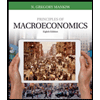Principles of Economics 2e 2nd Edition
ISBN: 9781947172364
Author: Steven A. Greenlaw; David Shapiro
Publisher: Steven A. Greenlaw; David Shapiro
1 Welcome To Economics! 2 Choice In A World Of Scarcity 3 Demand And Supply 4 Labor And Financial Markets 5 Elasticity 6 Consumer Choices 7 Production, Costs, And Industry Structure 8 Perfect Competition 9 Monopoly 10 Monopolistic Competition And Oligopoly 11 Monopoly And Antitrust Policy 12 Environmental Protection And Negative Externalities 13 Positive Externalities And Public Goods 14 Labor Markets And Income 15 Poverty And Economic Inequality 16 Information, Risk, And Insurance 17 Financial Markets 18 Public Economy 19 The Macroeconomic Perspective 20 Economic Growth 21 Unemployment 22 Inflation 23 The International Trade And Capital Flows 24 The Aggregate Demand/aggregate Supply Model 25 The Keynesian Perspective 26 The Neoclassical Perspective 27 Money And Banking 28 Monetary Policy And Bank Regulation 29 Exchange Rates And International Capital Flows 30 Government Budgets And Fiscal Policy 31 The Impacts Of Government Borrowing 32 Macroeconomic Policy Around The World 33 International Trade 34 Globalization And Protectionism A The Use Of Mathematics In Principles Of Economics B Indifference Curves C Present Discounted Value D The Expenditure-output Model Chapter33: International Trade
Chapter Questions Section: Chapter Questions
Problem 1SCQ: True or False: The source of comparative advantage must be natural elements like climate and mineral... Problem 2SCQ: Brazil can produce 100 pounds of beef or 10 autos. In contrast the United States can produce 40... Problem 3SCQ: In France it takes one worker to produce one sweater, and one worker to produce one bottle of wine.... Problem 4SCQ: In Germany it takes three workers to make one television and four workers to make one video camera.... Problem 5SCQ: How can there be any economic gains for a country from both importing and exporting the same good,... Problem 6SCQ: Table 33.15 shows how the average costs of production for semiconductors (the chips In computer... Problem 7SCQ: If the removal of trade banters is so beneficial to international economic growth, why would a... Problem 8RQ: What is absolute advantage? What is comparative advantage? Problem 9RQ: Under what conditions does comparative advantage lead to gains from trade? Problem 10RQ: What factors does Paul Krugman identity that supported expanding international trade in the 1800s? Problem 11RQ: Is it possible to have a comparative advantage in the production of a good but not to have an... Problem 12RQ: How does comparative advantage lead to gains from trade? Problem 13RQ: What is intra-industry trade? Problem 14RQ: What are the two main sources of economic gains from intra-industry trade? Problem 15RQ: What is splitting up the value chain? Problem 16RQ: Are the gains from international trade more likely to be relatively more important to large or small... Problem 17CTQ: Are differences in geography behind the differences in absolute advantages? Problem 18CTQ: Why does the United States not have an absolute advantage in coffee? Problem 19CTQ: Look at Exercise 33.2. Compute the opportunity costs of producing sweaters and wine in both France... Problem 20CTQ: You just overheard your friend say the following: Poor countries like Malawi have no absolute... Problem 21CTQ: Look at Table 33.9. Is there a range of trades for which there will be no gains? Problem 22CTQ: You just got a job in Washington, D.C. You move into an apartment with some acquaintances. All your... Problem 23CTQ: Does intra-industry trade contradict the theory of comparative advantage? Problem 24CTQ: Do consumers benefit from intra-industry trade? Problem 25CTQ: Why might intra-industry trade seem surprising from the point of view of comparative advantage? Problem 26CTQ: In World Trade Organization meetings, what do you think low-income countries lobby for? Problem 27CTQ: Why might a low-income country put up barriers to trade, such as tariffs on imports? Problem 28CTQ: Can a nations comparative advantage change over time? What factors would make it change? Problem 29P: France and Tunisia both have Mediterranean climates that are excellent for producing/harvesting... Problem 30P: In Japan, one worker can make 5 tons of rubber or 80 radios. In Malaysia, one worker can make 10... Problem 31P: Review the numbers for Canada and Venezuela from Table 33.12 which describes how many barrels of oil... Problem 32P: In Exercise 33.31, is there an ask where Venezuelans may say no thank you to trading with Canada? Problem 33P: From earlier chapters you will recall that technological change shifts the average cost curves. Draw... Problem 34P: Consider two countries: South Korea and Taiwan. Taiwan can produce one million mobile phones per day... Problem 35P: If trade increases world GDP by 1 per year, what is the global impact of this increase over 10... Problem 23CTQ: Does intra-industry trade contradict the theory of comparative advantage?
Related questions
Specialization and Trade
Comparative Advantage Imports and Exports
Foreign Exchange
Globalization and Trade Barriers
Which of these five concepts affects you the most? Explain why.
Definition Video Definition Ability of a country to produce goods and services at a lower opportunity cost compared to other countries. Here, opportunity cost refers to the forgone units of one good in order to produce one more unit of another good. For example, the opportunity cost of producing good X in country A is 2Y and in country B is 1.25Y. Country B has a lower opportunity cost of producing good X than country A. Therefore, country B has a comparative advantage in the production of good X. Video
Expert Solution
This question has been solved!
Explore an expertly crafted, step-by-step solution for a thorough understanding of key concepts.
Step by step
Solved in 2 steps









